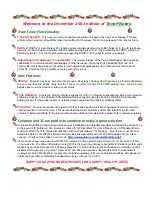
RVON-16
29
Bosch Security Systems, Inc.
Technical Manual
F.01U.193.291
Rev. 06
ACCESSING THE WIDE AREA NETWORK (WAN)
Figure 3 shows LAN IP Addresses using a common IP Address, 10.2.100.X (192.168.X.X is another common address). Most
devices are shipped with these addresses as its default. It is recommended to use these addresses for LANs.
NETWORK ADDRESS TRANSLATION (NAT)
Using the initial IP Address, then converting it to a valid WAN IP Address is how the network address translation works, in
theory. Once the IP address is changed, it is up to the network interface device (such as a router, gateway, switch, etc.) to keep
track of which computers are talking on which ports. For example, if two local devices (PC1 and PC2 in Figure 3) both wanted
to talk via port 1031, then the network interface device would have to change one of the port requests to the next available port,
1032.
PORTS
In general, a network port is an endpoint to a logical connection. The port number identifies what type of port it is. For
example, port 80 is used for HTTP traffic. When you type an address into the
address bar
of a web browser, your computer
goes to find an IP Address
for the url you are requesting (http://www.telex.com). To obtain this address, the computer contacts
a DNS server (Domain Name Server). Once the IP Address is found, it tries to connect to the http port of the network device
(port 80). See Table 1 for a list of the more well-known port numbers.
Each network device can be set-up to respond or not respond to the various ports. The function of responding or “hosting a
service” is called “serving”.
If a second workstation on the LAN wants to communicate to the same server, and happens to use the same source port
number, then the LAN Modem translates the source port number as well as the source IP address. In Table, 2, a second LAN
computer wants to access a web page. The NAT device now uses port 1032 for this connection where it used port 1031 in
Table 1.
FIGURE 8.
Network Address Translation
TABLE 2.
Packet Translation
Packet before Translation
Packet after Translation
Source
Destination
Source
Destination
IP Address
Port
Number
IP Address
Port
Number
IP Address
Port
Number
IP Address
Port
Number
To
Internet
10.2.100.2
1031
192.156.136.22
80
99.5.1.30
1031
192.156.136.22
80
From
Internet
192.156.136.22
80
99.5.1.30
1031
192.156.136.22
80
10.2.100.2
1031
Содержание RVON-16
Страница 1: ...F 01U 193 291 Rev 06 DECEMBER 2011 RVON 16 RTS Voice Over Network...
Страница 4: ...Bosch Security Systems Inc Technical Manual F 01U 193 291 Rev 06 iv RVON 16...
Страница 10: ...6 Introduction RVON 16 Bosch Security Systems Inc Technical Manual F 01U 193 291 Rev 06...
Страница 42: ...38 RVON 16 Bosch Security Systems Inc Technical Manual F 01U 193 291 Rev 06...
Страница 45: ...RVON 16 41 Bosch Security Systems Inc Technical Manual F 01U 193 291 Rev 06 FIGURE 11 ADAM Trunking Via RVON 8...
Страница 48: ...Bosch Security Systems Inc Technical Manual F 01U 193 291 Rev 06 44 RVON 16 FIGURE 14 RVON 16 Trunking...
Страница 49: ...RVON 16 45 Bosch Security Systems Inc Technical Manual F 01U 193 291 Rev 06 Notes...
Страница 50: ...Bosch Security Systems Inc 12000 Portland Avenue South Burnsville MN 55337 U S A www boschcommunications com...































